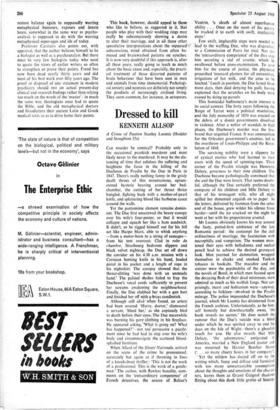Dressed to kill
KENNETH ALLSOP
A Crime of Passion Stanley Loomis (Hodder and Stoughton 35s)
Can murder be comical? Probably only to the occasional prankish murderer and most likely never to the murdered. It may be the dis- tancing of time that subdues the suffering and heightens the farce in the killing of the Duchesse de Praslin by the Duc in Paris in 1847. There's really nothing funny in the grisly death throes of this mountainous, opium- stoned hysteric heaving around her bed- chamber, the cutting of her throat thrice bungled, fighting back with a mother-of-pearl knife, and splattering blood like barbecue sauce around the walls.
Yet the pantomime element remains domin- ant. The Duc first unscrewed the heavy canopy over his wife's four-poster, so that it would collapse and squash her like a ham sandwich. It didn't, so he rigged himself out for his fell act like Harpo Marx, able to whisk anything —from a motor-horn to a string of sausages— from his tent overcoat. Clad in robe de chambre, Strasbourg bedroom slippers and black velvet nightcap, the Duc set off down the corridor on his 4.30 a.m. mission with a Corsican hunting knife in his hand, loaded pistol in his pocket and a length of rope in his nightshirt. The autopsy showed that the throat-slitting 'was done with an unsteady hand.' The palsied slashes failed. to fray the Duchesse's vocal cords sufficiently to prevent her screams awakening the neighbourhood. Finally, the Duc clubbed her with a gun butt and finished her off withilfbrass candlestick.
Although still alive' when -found, an artery had been severed. 'Hurry, doctor,' clamoured a servant, 'bleed her,!. as she copiously bled to death before their eyes. The Due meanwhile was burning his goryr:clothing in his fireplace. He appeared asking, `What is going on? What has happened?'—not too persuasive a puzzle- ment since he had had to step over his wife's body and circumnavigate the, scattered blood- splashed furniture.
When Allard of the Siirete Nationale, arrived on the scene of the crime he pronounced, accurately but again as if throwing in lines of a knockabout thriller: 'This is not the work of a professional. This is the work of a gentle- man.' The author, with flawless banality, com- ments on the 'extraordinary competence' of French detectives, the source of Balzac's Vautrin, 'a sleuth of almost superhuman ability . . . Once on the scent of his quarry he tracked it to earth with swift, implacable steps.'
Few swift, implacable steps were needed to lad to the waffling Duc, who was dispatched to a Commission of Peers for trial. Nor did the 'extraordinary competence' of the flies stop him secreting a vial of arsenic, which he swallowed before cross-examination. To save him for the course of justice, the physician prescribed 'mustard plasters for all extremities, irrigations of hot milk, and the anus to be leeched.' Leech in position, the Duc lasted three more days, then died denying his guilt, having explained that the scratches on his body were caused by doing up parcels: This homicidal buffoonery's main interest is its social context. The forty years following the Reign of Terror were a political maelstrom, And the July monarchy of 1830 was erected on the debris of a dozen governments dissolved in violence. After a welter of scandals in high places, the Duchesse's murder was the- fire- brand that reignited France. It was ammunition for the Orleanist government's enemies, led to the overthrow of Louis-Philippe and the Revo- lution of 1848.
The surviving nobility were a slippery lot of cynical exotics who had learned to .turn coats with the speed- of spinning-tops. Third corner of the Praslin triangle was Henriette Deluzy, governess to their nine children. The Duchesse became pathologically convinced that she and the Duc were lovers. That seems doubt- ful, although the Duc certainly preferred the company of his children and Mlle Deluzy to that of his termagant wife, who all night spilled her demented anguish on to paper. As the letters, delivered by footman from the other end of the house, grew wilder his silence froze harder—until the ice cracked on the might te went at her with his preposterous arsenal.
Mr Loomis obviously knows his way around the fusty, potted-fern ambience of the late Romantic period : the contempt for the dull ordinariness of marriage, the fascination with necrophilia and vampirism. The women mois- tened their eyes with belladonna and sucked pencil lead to achieve the desired graveyard look. Men yearned for damnation, wrapped themselves in cloaks and smoked Turkish tobacco in hookahs. The macabre and the sinister were the psychedelia of the day, and the novels of Borel, in which men feasted upon the decaying flesh of their dead mistresses, were admired as much as his wolfish fangs. Not sur- prisingly, incest and lesbianism were—anyway, according to folklore—involved in the Praslin menage. The police impounded the Duchesse's journal, which Mr Loomis has disinterred from the French archives. Unfortunately, as he him- self- honestly but downheartedly owns, 'the book reveals -no secrets.' He does scotch the rumour that the Due's suicide was a blind under which he was spirited away to end his days on the Isle of Wightr—there's a ghoulish touch for you. He - also reveals that Mlle Deluzy, 'the adventuress,' emigrated to America, married a New England pastor and was mourned by Harriet Beecher Stowe C. . . so many cheery hours in her company). ' Yet the mildew has- dusted off on to the writing which, fuzzy and diffuse and furnished with too many unwarrantable assumptions about the thoughts and emotions of the charac- ters, leaves them as Grand Guignol shadows flitting about this dank little grotto of history.


































 Previous page
Previous page